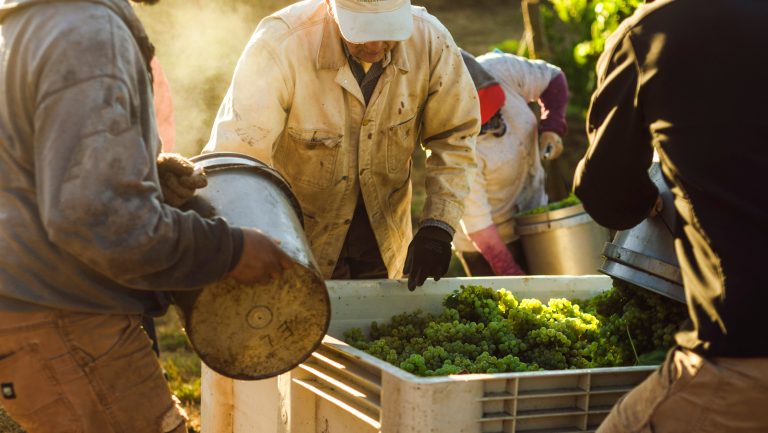Many consider the Willamette Valley to be the New World’s finest Pinot Noir region, with comparisons commonly being made to the grape’s Burgundian homeland. Despite the area’s dedication to Pinot Noir, there has been little focus on the grape’s natural white counterpart, Chardonnay, throughout the Willamette’s 50-year history—until now. Over the past three years, high-quality Willamette Valley Chardonnays have surged onto the market from both established and new producers. Where has the other Burgundian grape been all this time—and what’s ahead?
Why Chardonnay Couldn’t Compete
The emergence of Chardonnay in the Willamette Valley is less a birth than a rebirth, a renaissance of sorts. “Oregon has had outstanding examples of Chardonnay since our beginnings, but they were few and far between,” says Josh Bergström, the owner, winemaker, and general manager of Bergström Wines.
While Bergström says Chardonnay was lacking in the Willamette Valley in 1999, when his family winery was just getting started, Chardonnay vines were actually first planted simultaneously with Pinot Noir in the mid-1960s. Most vintners credit the Willamette Valley’s first Chardonnay vines to David and Diana Lett, who founded Eyrie Vineyards in 1965. David Adelsheim, the founder of Adelsheim Vineyard and an early proponent of Chardonnay, notes that the grape was commonly planted in the valley throughout the 1960s, 1970s, and early 1980s.

Don’t miss the latest drinks industry news and insights. Sign up for our award-winning newsletters and get insider intel, resources, and trends delivered to your inbox every week.
As Pinot Noir took off in the 1980s, however, Chardonnay declined. While some attribute Chardonnay’s lack of success to clonal selection—according to Adelsheim, much of what was planted was selection 108, a virus-resistant, large-clustered clone that didn’t ripen sufficiently in the cool Willamette Valley—others attribute it to a difficulty in distinguishing the wines from the ever-popular California Chardonnays.
“Burgundy was entrenched as the reference standard, and California was established as the successful sales model for American Chardonnay,” Bergström says. “It was just too hard to compete, so as an industry, we focused on Pinot Noir, which did not have the level of American competition.” Only a handful of Willamette Valley producers persisted through the “anything but Chardonnay” movement of the late 1990s—fewer than 25, according to Bergström, and hardly any were focused on producing high-quality Chardonnays.
This small Chardonnay selection did garner some recognition, however, which fueled enthusiasm from emerging winemakers in the last decade. One of these vintners was Isabelle Meunier, the cofounder and winemaker of Lavinea, who says that there were just 4 acres of Chardonnay planted amid 60 acres of Pinot Noir when she joined the current leading Chardonnay producer, Evening Land Vineyards, in 2007. “The great wines that we were able to make from that little area,” says Meunier, “truly confirmed that Chardonnay belongs [in] the Willamette Valley.”

The Making of a World-Class Wine
The Willamette Valley was always a suitable place for Chardonnay, and now it’s the right time for the grape. Though the amount of Chardonnay planted in the valley is still relatively small—a mere 1,483 acres in 2016 to Pinot Noir’s 15,643 acres—many new vines are planted each year. Says Adelsheim, “Chardonnay is the variety that [many] Willamette Valley winemakers are most excited about.”
Stylistically, Willamette Valley Chardonnay certainly has an Old World quality, with that push-pull between richness and focus. Though producers agree on a general Willamette Valley style—“acidic but not austere, and opulent but not overblown,” Bergström notes—much remains undetermined about optimal mesoclimates, soils, and practices in the vineyard and cellar.
“Chardonnay will need to be much more densely planted in all the AVAs before we can back up our answers with wine in a glass,” Adelsheim says. In the meantime, vintners see potential for Chardonnay in all areas of the valley; as Adelsheim and Bergström both point out, Chardonnay thrives in both volcanic and sedimentary soils. Other local winemakers also note that Chardonnay translates individual site nuances and producer styles exceptionally well, much like Pinot Noir.
Though Willamette Valley Chardonnay typically requires a hand-sell on the floor, it’s one that consumers are primed to accept. Those with discerning palates are more likely to steer away from overblown, oak-driven whites in favor of acid- and mineral-driven options. “People are realizing that they gave up on Chardonnay too early,” says Brian McClintic, a Master Sommelier and the founder of the Viticole wine clubs. “Now they’re revisiting places like Oregon, where, dollar for dollar, you’re putting up a huge fight on the world’s stage.” While Willamette Chardonnays aren’t inexpensive, top versions retailing for above $50 offer incredible value compared with good-quality white Burgundy.
“We are on the cusp of Willamette Valley Chardonnay being widely considered a world-class wine,” says Casey Chamberlin, the beverage director and general manager of RingSide Fish House in Portland, Oregon. Chamberlin, who currently offers 18 Chardonnays from the Willamette Valley on the restaurant’s wine list, notes that lovers of white Burgundy tend to be receptive to Oregon’s Chardonnays. Willamette Chardonnays even show potential to mimic white Burgundy’s ageability, but as with other category details, more time is needed to determine how these wines will measure up.
“So much of our enthusiasm and discussion of quality is more about what we will be able to show people in the future than what we can sell today,” Adelsheim says. If the region’s rapid rise to hallmark Pinot Noir status is any indication, it’ll just be a matter of time before Willamette Valley Chardonnay becomes a benchmark as well.

Dispatch
Sign up for our award-winning newsletter
Don’t miss the latest drinks industry news and insights—delivered to your inbox every week.
Courtney Schiessl Magrini is the editor-in-chief for SevenFifty Daily and the Beverage Media Group publications. Based in Brooklyn, she has held sommelier positions at some of New York’s top restaurants, including Marta, Dirty French, and Terroir, and her work has appeared in Wine Enthusiast, GuildSomm, Forbes.com, VinePair, EatingWell Magazine, and more. She holds the WSET Diploma in Wines. Follow her on Instagram at @takeittocourt.






